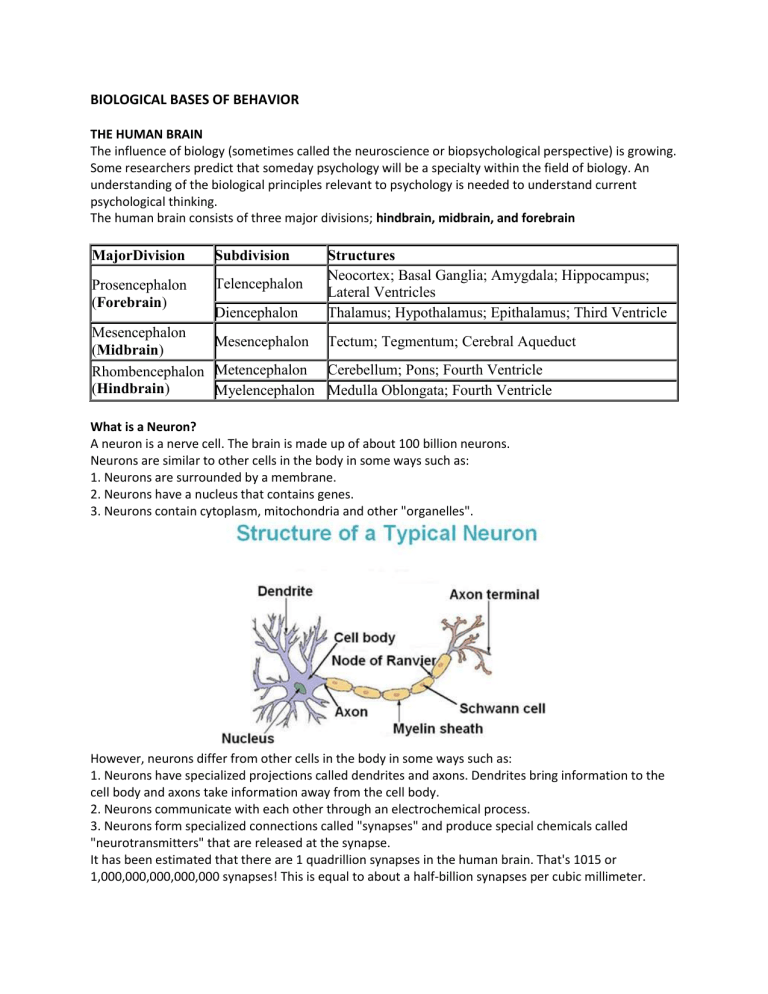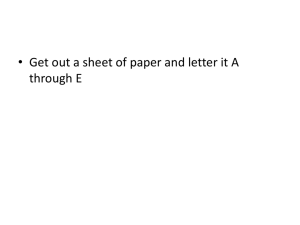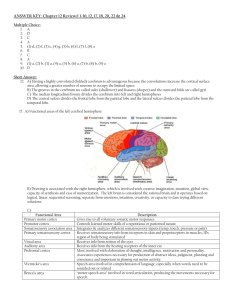BIOLOGICAL BASES OF BEHAVIOR NOTES

BIOLOGICAL BASES OF BEHAVIOR
THE HUMAN BRAIN
The influence of biology (sometimes called the neuroscience or biopsychological perspective) is growing.
Some researchers predict that someday psychology will be a specialty within the field of biology. An understanding of the biological principles relevant to psychology is needed to understand current psychological thinking.
The human brain consists of three major divisions; hindbrain, midbrain, and forebrain
(
MajorDivision
Prosencephalon
Forebrain )
Subdivision
Telencephalon
Structures
Neocortex; Basal Ganglia; Amygdala; Hippocampus;
Lateral Ventricles
Diencephalon Thalamus; Hypothalamus; Epithalamus; Third Ventricle
Mesencephalon
( Midbrain )
Mesencephalon Tectum; Tegmentum; Cerebral Aqueduct
(
Rhombencephalon
Hindbrain )
Metencephalon Cerebellum; Pons; Fourth Ventricle
Myelencephalon Medulla Oblongata; Fourth Ventricle
What is a Neuron?
A neuron is a nerve cell. The brain is made up of about 100 billion neurons.
Neurons are similar to other cells in the body in some ways such as:
1. Neurons are surrounded by a membrane.
2. Neurons have a nucleus that contains genes.
3. Neurons contain cytoplasm, mitochondria and other "organelles".
However, neurons differ from other cells in the body in some ways such as:
1. Neurons have specialized projections called dendrites and axons. Dendrites bring information to the cell body and axons take information away from the cell body.
2. Neurons communicate with each other through an electrochemical process.
3. Neurons form specialized connections called "synapses" and produce special chemicals called
"neurotransmitters" that are released at the synapse.
It has been estimated that there are 1 quadrillion synapses in the human brain. That's 1015 or
1,000,000,000,000,000 synapses! This is equal to about a half-billion synapses per cubic millimeter.
Neural Communication
Our Neural System is basically made up of nerve cells or neurons. Each neuron is composed of
Dendrites ~ message receiving fibers and Axons ~ message sending fibers which are insulated by the Myelin Sheath ~ fatty cells that help \speed up impulses.
Impulses or Action Potential is a brief electrical charge that travels down the axon as it becomes
Depolarized due to the movement of positively charged ions entering the axon. After the transmission, the axon becomes Polarized as positive ions are pumped out during the Refractory
Period.
The intensity of a stimulus is called the Threshold. A stimulus must exceed the threshold in order for a transmission to occur. The neuron will either fire or it won’t. Much like a gun, the neuron either fires or it doesn’t, there are no half-fires. This is called the all-or-none-response; if a stimulus is really strong, only the number of neurons firing will increase, not their speed.
The axon terminal of the sending neuron is separated from the receiving neuron by a tiny gap called the Synapse (or Synaptic Cleft). Once the action potential reaches the synapse, neurotransmitters, or chemical messengers, are released into the gap where it will bind onto specific receptor sites on the receiving neuron.
The most well know neurotransmitter is Acetylcholine (ACh), it causes muscles to contract in
movement.
Endorphins are natural opiates produced in the body to control pain and induce pleasure.
("Morphine within")
Agonists are molecules which mimics the shape of natural neurotransmitters (Morphine)
Antagonists are molecules which block neurotransmitters from binding on receptor sites
The brain has a Blood-brain barrier which filters out unwanted chemicals in blood stream.
Neural Systems
The Nervous System is composed of the Central Nervous System (CNS) – brain and spinal cord, and Peripheral Nervous System (PNS) – links CNS to body’s muscles and glands by means of nerves which are bundles of sensory and Motor Neurons (they carry incoming and outgoing information respectively).
The Autonomic Nervous System (under PNS) has Sympathetic Nervous System – arouses the body for defense (increase heartbeat, dilating pupils, inhibit digestion etc.) and Parasympathetic
Nervous System – calms the body after stress.
A simple Reflex is an automatic response to stimuli (like knee-jerk) involving messages from
Sensory to Interneuron (Spinal Cord) to Motor Neuron.
The Brain
Franz Gall developed the false theory called Phrenology – where bumps on the head dictate personality and intelligence. But the theory did direct our attention to brain region and function.
Psychologists that study these connections between biology and behavior are called Biological
Psychologist
Lesions – remove brain tissue
Electroencephalogram (EEG) – measures brain electric activity
Computed Tomograph (CT or CAT Scan) – taking x-ray photographs of brain
Positron emission tomograph (PET Scan) – detects radioactive glucose consumption in brain
Magnetic Resonance imaging (MRI) – generates brain images from magnetic activity
The brainstem – oldest portion in brain forms into the Medulla Oblongata – regulates involuntary processes like heartbeat and breathing.
Within the brainstem lies the reticular formation (looks like a finger-shaped net) which controls arousal, when you wake or sleep.
The Thalamus lies above brainstem and is shaped like two eggs. Its function is to act as a sensory switchboard relaying incoming signals to appropriate brain regions. But does not relay sensory
signals dealing with smell.
The Cerebellum stores partial memory and learning capacities. But it mainly controls balance.
Limbic System includes Amygdala – influence emotions (fear, anger), and the Hippocampus – process memory . Removal of amygdala results in emotionless organisms upon arousal.
The Hypothalamus maintains body homeostasis (temperature, hunger, growth) and governs pituitary.
Glial cells guide and support nerve cells in the brain.
The brain is divided into 4 regions.
Frontal Lobe – behind forehead – has Motor Cortex (located at the back of frontal lobe, the cortex controls voluntary movement)
Parietal Lobe – top to back of head – has Sensory Cortex (located in the beginning of parietal lobe, the cortex processes \bodily senses)
Occipital Lobe – back of head – regulates vision.
Temporal Lobe – above ears – regulates hearing
¾ of the brain is uncommitted to motor or sensory functions. Theses brain regions are called
Association Areas – areas involved in thinking, remembering, and speaking. The larger the association area, the more intelligent the species for they are able to anticipate future events.
The case with Phineas Gage showed researchers that damages in the frontal lobe could result in personality alterations because their normal "restraints" or inhibitions are erased. This was due to a tamping rod that shot from his left cheek and out his head, separating his internal motives and external judgement.
Stages of Language :
1.
Visual Cortex – occipital lobe (back of head) – sees the visual stimulation (words)
2.
Angular Gyrus – mid-side of parietal lobe – converts words into auditory code
3.
Wernicke’s Area – between temporal and parietal lobe (side of head) - derives meaning from auditory code
4.
Broca’s Area – mid-bottom of frontal lobe – controls motor cortex
Damage to (1) cannot see, (2) cannot read, (3) cannot understand, (4) and (5) cannot speak.
5.
Motor Cortex – back of frontal lobe – activates speech muscles to pronounce word
Corpus Callosum joins the two hemispheres and is separated to cure epileptic seizures.
People with separated corpus callosums are referred to as Spilt-brain patients. They are unable to say what they see in their left visual field because speech is in left hemisphere and the hemispheres regulate opposite sides of body.
When split-brainers are asked to say what they saw, the left hemisphere will say what is seen in right visual field; when asked to point, get, or write what they saw, the right hemisphere will dictate what is seen in the left visual field.
Sign language is nevertheless language and is control by left hemisphere, if deaf people get a stroke in left hemisphere, signing will be disrupted.
Left Hemisphere : Mathematics, language, logical, reasoning. meaning
Right Hemisphere : Perceptual tasks, musical, artistic, emotion, face recognition, copying information
Ways of studying the brain: Accidents, Lesions, Electroencephalogram, Computerized axial tomography, Magnetic resonance imaging (MRI), Positron emission tomography, Functional
MRI, Neuroanatomy
Hormonal Systems
The Endocrine System (slow hormone secreting system) communicates by releasing Hormones
(chemical messengers) into the bloodstream.
In times of stress the ANS will signal Adrenal Glands (above kidney) to release epinephrine and norepinephrine hormones (also called adrenaline and noradrenaline.)
Pituitary gland is the most powerful endocrine gland, and under the influence of hypothalamus in brain, pituitary releases hormones that regulate glands and growth.
Genetics and Behavior
Chromosomes contain Genes which are made up of DNA. There are 23 chromosomes in human egg and sperm; they are combined (fertilized) to make a 46 chromosome cell.
Evolutionary Psychologists study the effects of evolution of behavior of organisms.
Behavior Geneticists study genetic and environmental effects on behavior. – using Linkage
Analysis.
Psychologists study Identical Twins (two babies within one egg) and Fraternal Twins (two babies in 2 separate eggs) to contrast adoption studies.
Identical twins have more similarities than fraternal twins.
Hertitability tell us what percentage of traits are because of genetic factors. o Traits (height, intelligence, eye color etc.) are either due to genetic or environment there are no half-halves. If heritability of intelligence is 70%, that means 70% of the people will have inherited intelligence
BIOLOGICAL BASIS OF BEHAVIOR QUIZ
1. Blindness could result from damage to which cortex and lobe of the brain?
A. visual cortex in the frontal lobe
B. visual cortex in the temporal lobe
C. sensory cortex in the parietal lobe
D. visual cortex in the occipital lobe
E. cerebral cortex in the occipital lobe
2. Paralysis of the left arm might be explained by a problem in the
A. motor cortex in the frontal lobe in the left hemisphere.
B. Motor cortex in the frontal lobe in the right hemisphere.
C. Sensorimotor cortex in the temporal lobe in the left hemisphere.
D. Motor cortex in the parietal lobe in the left hemisphere.
E. Motor cortex in the occipital lobe in the right hemisphere.
3. Deafness can result from damage to the inner ear or damage to what area of the brain?
A. Connections between the auditory nerve and the auditory cortex in the frontal lobe.
B. Connections between the auditory nerve and the auditory cortex in the temporal lobe.
C. Connections between the areas of the sensory cortex that receive messages from the ears and the auditory cortex.
D. Connections between the hypothalamus and the auditory cortex in the temporal lobe.
E. Connections between the left and right sensory areas of the cerebellum.
4. According to the theory of evolution, why might we call some parts of the brain the old brain and some parts of the new brain?
A. Old brain parts are what exist in very young children, and the new brain develops later
B. The old brain developed first according to evolution.
C. The old brain becomes more active as we grow older.
D. The new brain deals with new information, while the old brain deals with information gathered when we were children.
E. The old brain is most affected by age deterioration (dementias) while the new brain remains unaffected.
5. Which chemicals pass across the synaptic gap and increase the possibility the next neuron in the chain will fire?
A. synaptic peptides
B. inhibitory neurotransmitters
C. adrenaline-type exciters
D. excitatory neurotransmitters
E. potassium and sodium
6. You eat some bad sushi and feel that you are slowly losing control over your muscles.
The bacteria you ingested from the bad sushi most likely interferes with the use of
A. Serotonin
B. Dopamine
C. acetylcholine
D. thorazine
E. adrenaline
7. The three major categories researchers use to organize the entire brain are the
A. old brain, new brain, and cerebral cortex
B. lower, middle, and upper brain.
C. Hindbrain, midbrain, and forebrain.
D. Brain stem, limbic system, and cerebral cortex
E. Neurons, synapses, and cerebral cortex.
8. A spinal reflex differs from a normal sensory and motor reaction in that
A. a spinal reflex occurs only in response to extremely stressful stimuli.
B. In a spinal reflex, the spine moves the muscles in response as soon as the sensory information reaches the spine while usually the impulse must reach the brain before a response.
C. In a normal sensory/motor reaction, the spine transmits the information through afferent nerve fibers, while reflex reactions are transmitted along special efferent nerves.
D. Spinal reflexes are part of the central nervous system response, while normal sensory/motor reactions are part of the peripheral nervous system.
E. Spinal reflexes occur only in animals because humans are born without instinctual responses.
9. Antidepressant drugs like Prozac are often used to treat mood disorders. According to what you know about their function, which neurotransmitter system do these types of drugs try to affect?
A. serotonin
B. adrenaline
C. acetylcholine
D. endorphins
E. morphine
10. Which sentence most closely describes neural transmission?
A. An electric charge is created in the neuron, the charge travels down the cell, and chemicals are released that cross the synapse to the next cell.
B. A chemical change occurs within the cell, the change causes an electric charge to be produced, and the charge jumps the gap between the nerve cells.
C. The electric charge produced chemically inside a group of neurons causes chemical changes in surrounding cells.
D. Neurotransmitters produced in the hindbrain are transmitted to the forebrain, causing electric
changes in the cerebral cortex.
E. Neural transmission is an electrochemical process both inside and outside the cell.
11. Dr. Dahab, a brain researcher, is investigating the connection between certain environmental stimuli and brain processes. Which types of brain scans is he most likely to use?
A. MRI and CAT
B. CAT and EKG
C. PET and EEG
D. EKG and CAT
E. Lesioning and MRI
12. Split-brain patients are unable to
A. coordinate movements between their major and minor muscle groups.
B. Speak about information received exclusively in their right hemisphere.
C. Speak about information received exclusively in their left hemisphere.
D. Solve abstract problems involving integrating logical (left-hemisphere) and spatial (right hemisphere) information.
E. Speak about information received exclusively through their left ear, left eye, or left side of their bodies.
13. When brain researchers refer to brain plasticity , they are talking about
A. the brain’s ability to regrow damaged neurons.
B. The surface texture and appearance caused by the layer known as the cerebral cortex.
C. The brain’s versatility caused by the millions of different neural connections.
D. Our adaptability to different problems ranging from survival needs to abstract reasoning.
E. New connections forming in the brain to take over for damaged sections.
14. Mr. Spam is a 39-year-old male who has been brought into your neurology clinic by his wife. She has become increasingly alarmed by her husband’s behavior over the last four months. You recommend a CAT scan to look for tumors in the brain. Which two parts of the brain would you predict are being affected by the tumors? List of symptoms: vastly increased appetite, body temperature fluctuations, decreased sexual desire, jerky movements, poor balance when walking and standing, inability to throw objects, and exaggerated efforts to coordinate movements in a task
A. motor cortex and emotion cortex
B. motor cortex and hypothalamus
C. hypothalamus and cerebellum
D. cerebellum and medulla
E. thalamus and motor cortex
15. In most people, which one of the following is a specific function of the left hemisphere that is typically not controlled by the right hemisphere?
A. producing speech
B. control of the left hand
C. spatial reasoning
D. hypothesis testing
E. abstract reasoning








